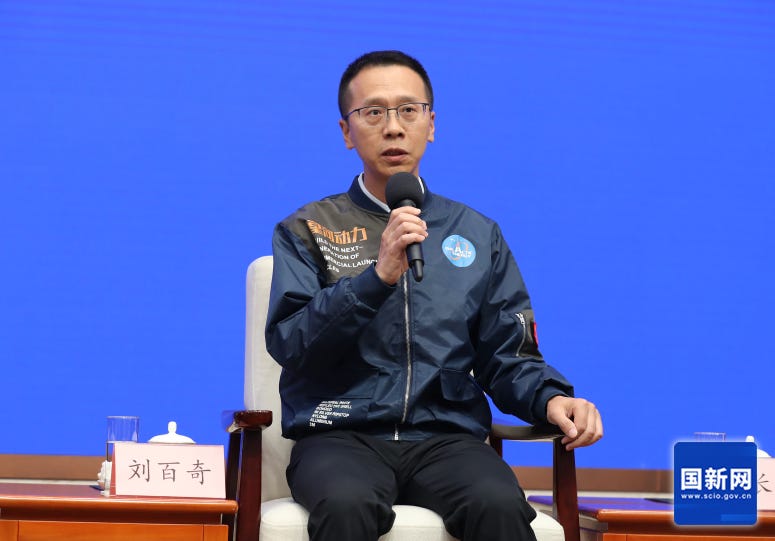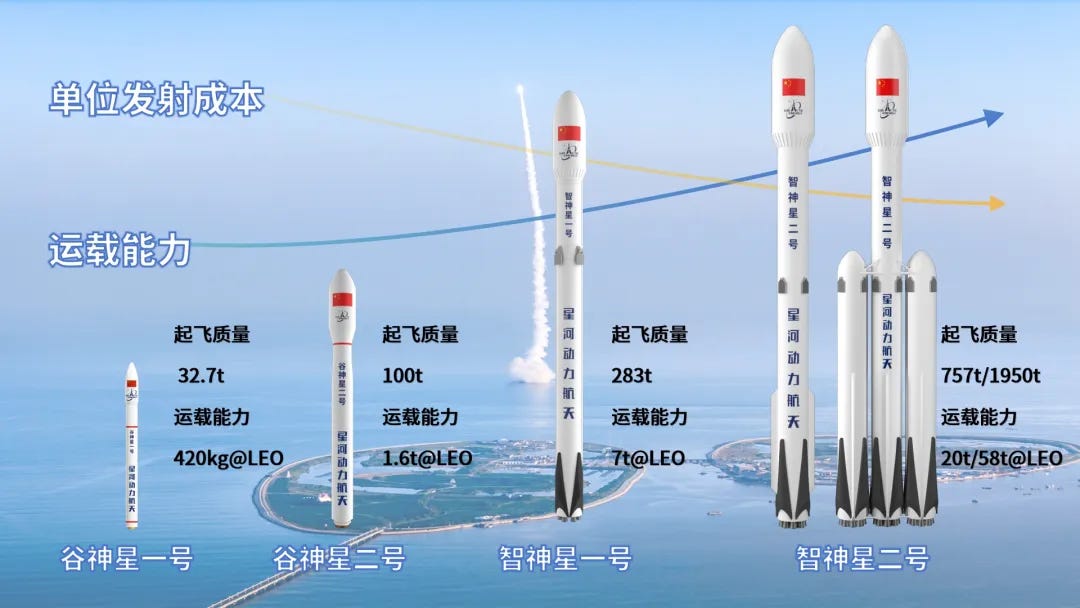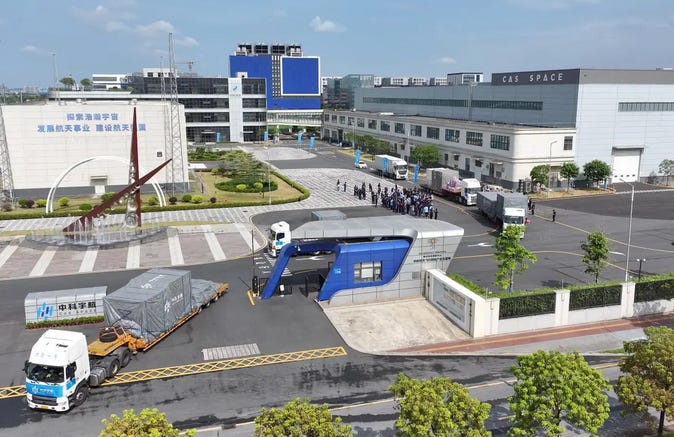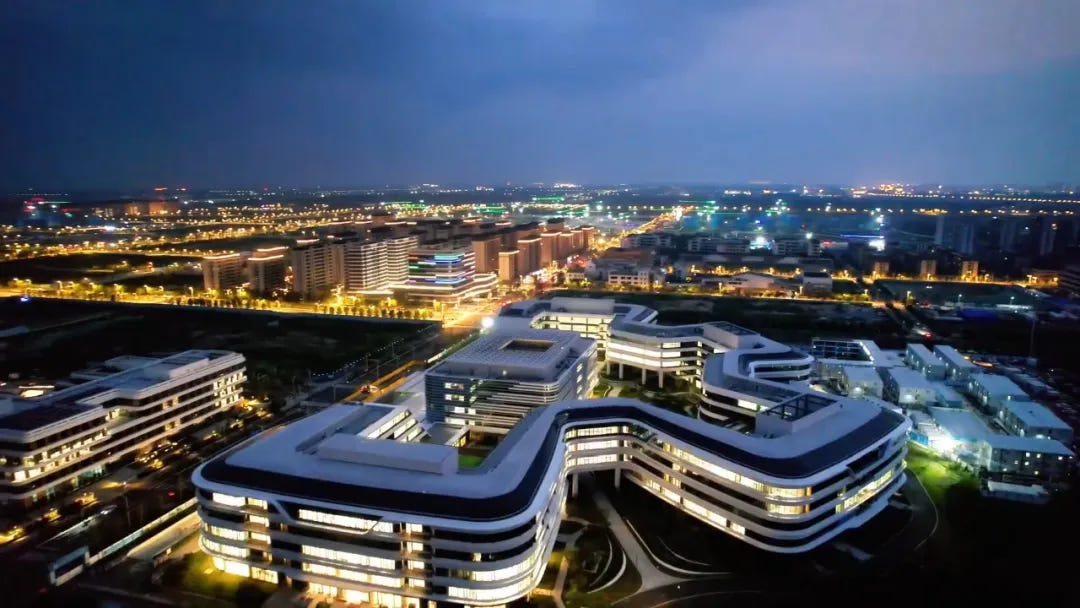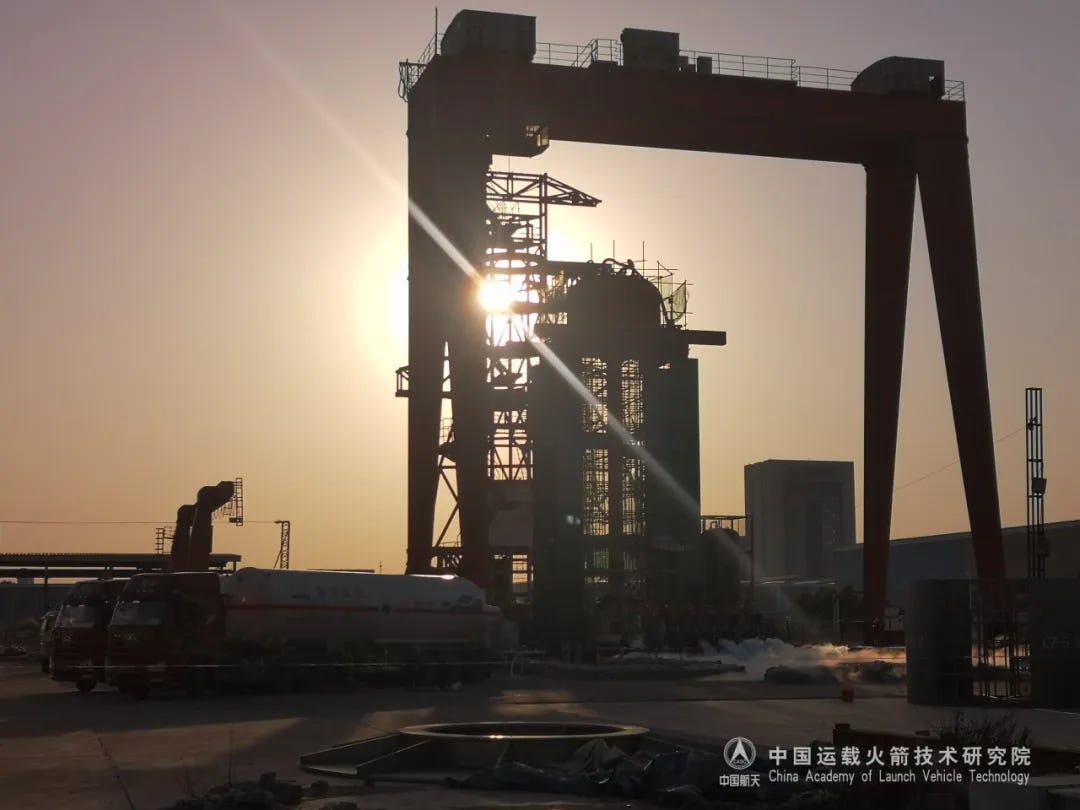Financing, a Panel Talk, Testing, and Rocket Delivery
Also a quiet update on the Long March 10?
Ahead of the recent release of new regulations, China’s space sector is continuing its usual busy activity to grow the sector and develop reusable rockets. Recent efforts include new tests, new financing, and a rocket being shipped out.
Space Pioneer conducts Tianlong-3 rehearsals
Space Pioneer shared on July 23rd that it has completed rehearsals for moving and standing a Tialong-3 vehicle in its launch position at the Jiuquan Satellite Launch Center, utilizing a full-scale mockup of the rocket.
Rehearsals with the mockup vehicle took place at Space Pioneer’s dedicated launch pad at the launch center, which over around the past year has been constructed. Facilities at the company’s launch pad include a horizontal vehicle assembly building, propellant storage tanks and plumbing to fuel the rocket, a flame trench underneath a launch table with a rocket erector (tested in July 2024), and two gigantic lightning diversion towers (hopefully equipped with cameras).
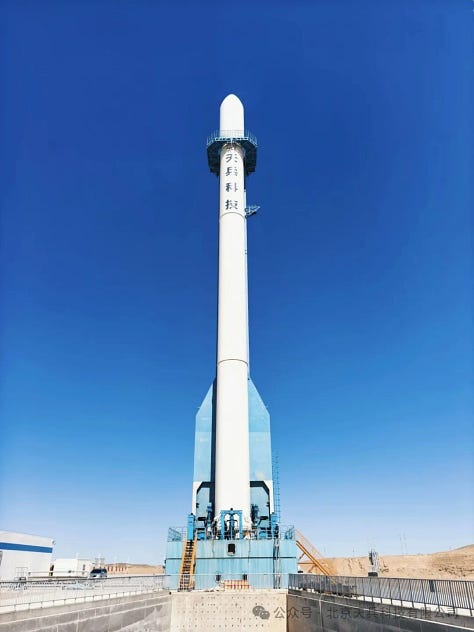
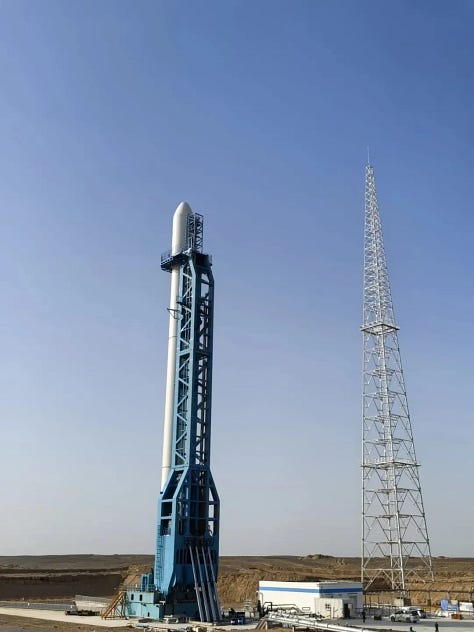
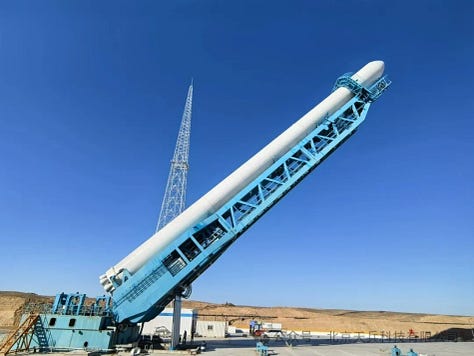
The rehearsal came around two weeks after the company shared fixes to Tianlong-3 following a test failure last year.
Tianlong-3 is a two-stage liquid-fuelled partially reusable launch vehicle expected to be capable of carrying 17,000 kilograms to low Earth orbit. The vehicle’s first-stage is expected to land after supporting a launch, guided by four grid fins and touching down on four landing legs after a short burn with between one and three of the first-stage’s engines. At the moment, Tianlong-3 is likely to debut later this year.
Shenzhou-19 crew awarded medals
Cai Xuzhe (蔡旭哲), Wang Haoze (王浩泽), and Song Lingdong (宋令东) of the Shenzhou-19 mission to China’s Tiangong Space Station returned to Earth on April 30th and made their first public appearance since returning at a press conference on July 9th. Recently, the missions crew has been awarded medals, with Cai Xuzhe receiving a second-class aerospace achievement medal (Cai has already received the title of “Heroic Astronaut” in 2023) while Song Lingdong and Wang Haoze received third-class aerospace achievement medals and the honorary title of "Heroic Astronaut".
Galactic Energy CEO on entrepreneurship, reveals new rocket
Chief Executive Officer of Galactic Energy Liu Baiqi (刘百奇), of the solid-fueled Ceres and upcoming reusable Pallas series of launch vehicles, spoke at China’s State Council Information Office on a panel regarding entrepreneurship in innovative sectors. While he spoke on the panel, Liu Baiqi touched on why he chose to become a space launch entrepreneur and shared some details on a new rocket.
An English transcript of the press conference has not been released, but a Chinese-language one has. As such, I’ve prepared an unofficial translation of Liu Baiqi’s parts, and it is provided below. Any errors present are my own, if you find any problems with this translation please reach out and correct me. If you are looking to reference any part of the transcript, please refer to the Chinese one posted by China’s State Council Information Office.
Liu Baiqi: Hello everyone, I'm Liu Baiqi, founder of Galactic Energy. I earned my PhD from Beihang University (Beijing University of Aeronautics and Astronautics). After graduation, I first stayed at the university as a teacher, then transferred to work at the China Academy of Launch Vehicle Technology. In 2018, responding to the national "mass entrepreneurship and innovation" initiative, I decided to start my own business and, together with my team, founded a private rocket manufacturing company—Galactic Energy. Our business model is to use our self-developed rockets to send customers' satellites into space, then collect launch service fees and transportation costs. You can also think of our company as a "space courier" service. We target markets like low Earth orbit satellites and internet services.
According to relevant statistics, tens of thousands of such satellites may need to enter space over the next 10 years, creating enormous market demand for rockets as specialized space transportation tools. Based on market demand, our company has developed two series and four models of launch vehicles: the Ceres and Pallas series. If we compare them to ground transportation, it's like we have both cars and buses, with payload capacities ranging from hundreds of kilograms to several tons or dozens of tons. In the future, they can be reused, significantly reducing costs. To date, we have completed 19 rocket launch missions, sending 81 satellites into space, making us the domestic private rocket company with the most launches and highest success rate.
Although we have achieved some success in the past, looking ahead, there are still many challenges. I'm very happy to share our entrepreneurial story and ideas with everyone on this occasion.
China Media Group: General Secretary Xi Jinping emphasized that the development prospects of the private economy are broad and promising, and it's the right time for private enterprises and entrepreneurs to make their mark. What moments or experiences on your entrepreneurial journey made you feel most that there are "great opportunities" and that "the timing is right"? How do you view the future development of private enterprises and the private economy?
Liu Baiqi: I'm an entrepreneur in the aerospace field. As an aerospace professional, I think there are many exciting moments that make us feel there are "great opportunities" and that "the timing is right." Today I want to share two things. First, on November 7, 2020, Galactic Energy's first self-developed product, the Ceres-1 rocket, achieved complete success on its maiden flight at the Jiuquan Satellite Launch Center. This was the first time China used a private company's rocket to send commercial satellites into a 500-kilometer sun-synchronous orbit. I was sitting in the mission control hall, watching the rocket soar into the sky, listening to the commands "rocket flight normal," and finally seeing the satellite smoothly separate from the rocket. When the launch center announced "mission complete success," we were extremely excited, knowing we had chosen the right path for commercial aerospace. I also believe that with national policy support, commercial aerospace will definitely have great potential in the future.
Let me share another story. On June 18 this year, the China Securities Regulatory Commission introduced new policies, establishing a science and innovation growth tier on the STAR Market and including commercial aerospace in the fifth set of standards. I think this made not just me, but all commercial aerospace entrepreneurs feel jubilant and particularly excited. Looking at the future of the private economy, I'm very confident. The country increasingly values the development of the private economy, and the policy environment continues to optimize, creating broad space for us. Private enterprises are playing an increasingly important role in technological innovation. More and more private companies are joining the commercial aerospace industry, collectively driving rapid development of the commercial aerospace sector. I believe that under the Party's leadership, private enterprises that adhere to seeking truth from facts and maintaining integrity while innovating will definitely reach broader stages. Thank you.
Reporter: China's commercial aerospace industry is currently developing vigorously. Why did Representative Liu Baiqi choose the commercial aerospace track? What drove your aerospace dream? Looking ahead, what are your expectations and plans? Thank you.
Liu Baiqi: The commercial aerospace industry is an emerging industry developing vigorously worldwide. This industry can combine an entrepreneur's entrepreneurial dreams with national economic development and even humanity's common destiny—it's a special industry worthy of lifelong dedication by aerospace professionals. In 2014, China introduced policies supporting and encouraging private capital and social forces to engage in aerospace research and production activities, strongly supporting the development of commercial aerospace. As an aerospace professional, I particularly cherish the policy opportunity for the country to open commercial aerospace to private enterprises. At the same time, I saw that the commercial aerospace market has very broad future prospects. In 2018, I resolutely decided to pursue my dreams and established Galactic Energy.
Regarding the future, I have thoughts in two areas. First, we're developing larger, more powerful launch vehicles. For example, we're currently developing the Pallas-2 rocket, a large reusable launch vehicle with a basic configuration payload capacity of 20 tons and a bundled configuration capacity of 60 tons. Through modular design, different modular combinations can adapt to various aerospace launch missions including low orbit, high orbit, and deep space exploration, and can be reused to significantly reduce aerospace launch costs. As reusable technology continues to improve, this rocket will also develop toward intelligence and scheduled flight operations.
Second, based on rocket technology, we're expanding other businesses. For example, we're expanding into on-orbit services and on-orbit testing. We and some partners plan to jointly develop space tourism business. We hope to have opportunities to participate in national deep space exploration and other major projects, using our technology to expand more commercial businesses and make greater contributions to the high-quality development of China's commercial aerospace. Thank you.
Reporter: [(This question was not directed at Liu Baiqi, but most mombers of the panel chose to answer it)] A question for Mr. Wang Xingxing from Unitree Technology. With the development of AI and other technologies, the application scope of humanoid robots is becoming increasingly broad. What kind of future do you envision between Unitree Technology's humanoid robots and humans? What is your development roadmap? How do you view the impact of current anti-globalization trends like increased tariffs and supply chain decoupling on your company? In this context, how will your company develop? Thank you.
Liu Baiqi: I believe excellent builders should have firm political positions, innovative entrepreneurial spirit, and a high sense of social responsibility. First, only with a firm political position can enterprises closely combine their own development with national strategy, correctly understand national policies, and achieve good development. Second, excellent builders should have innovative entrepreneurial spirit. Only by daring to break traditions, breakthrough, and innovate can enterprises achieve sustainable development. Finally, in the development process, enterprises should consider both their own development interests and actively contribute to society.
Speaking of myself, in this new era and new journey, I lead my team to continue persisting in rocket technology innovation, developing more advanced rocket technology, continuously reducing aerospace launch costs, and improving aerospace launch capabilities. We hope to provide more valuable aerospace launch services for China's aerospace market. At the same time, we actively fulfill social responsibilities. Our company has organized the "Galactic Cup" youth spacecraft concept design competition, spreading aerospace spirit and popularizing aerospace knowledge through this activity. We hope to cultivate more aerospace talent for the country through our activities, practicing entrepreneurial spirit through our actual actions. Thank you.
During his time speaking on the panel, Liu Baiqi shared some details on the Galactic Energy’s other partially reusable liquid-fulled launch vehicle, which has been hinted at in the past. Although not specifying many details, Liu stated that the Pallas-2 rocket will be capable of lifting around 20,000 kilograms to low Earth orbit in a single-core configuration, or about 58,000 kilograms in a tri-core configuration.
A graphic released by Galactic Energy after Liu spoke detailed that the rocket will be slightly taller than Pallas-1 while weighing 757,000 kilograms fully-fueled as a single-core rocket, or around 1,950,000 kilograms in a tri-core configuration. It is also probable that the company is working on a more capable engine for the rocket, based on the increase in capability, familiar architecture, and likely larger diameter.
CAS Space ships Kinetica-1, receives 2 billion line of credit
CAS Space announced on July 14th that they had been approved for a 2 billion Yuan (around 278.6 million United States Dollars, as of July 21st) line of credit from the Bank of Guangzhou (广州银行股份有限公司). This credit is planned to support the scaling up of the company’s competitiveness with current and future launch vehicles.
The company also shared on its Twitter account, two days later, how they will utilize the line of credit:
“CAS Space is now strategically partnered with Bank of Guangzhou with an RMB 2bn indicative credit line for empowering our R&D, manufacturing and operations. After completing multiple rounds of funding over the years, the collaboration will further enhance CAS Space's financing.”
The financing came a few days after the next Kinetica-1 launch vehicle bound for flight was shipped from the company’s manufacturing facility, on July 9th. According to the company, the rocket is set for flight in August and boasts improvements in payload capacity and optimizing space within the rocket’s fairing. This flight will be around three months after Kinetica-1’s return to flight mission, launched on May 21st.
Hyperbola-3 performs cryogenic stress tests
iSpace revealed on July 12th that Hyperbola-3’s liquid methane propellant tank performed a cryogenic static pressure stress test. For the test, liquid nitrogen was loaded into the tank before a series of pulleys stressed the tank’s structure to mimic some high-stress flight conditions.
According to the company, the test further verified the design of Hyperbola-3’s propellant tanks, which are 4.2 meters in diameter with a length of around 17 meters.
This test follows a cryogenic proof test performed back in April. iSpace is still believed to be aiming for a December debut of Hyperbola-3.
GuoWang compensation leaked
The GuoWang (郭望) mega-constellation operated by China Satellite Network Group, backed by the Chinese government with 34 satellites in orbit, has supposedly had its employee salaries leaked online.
According to a report on the subject, China Satellite Network Group is offering newcomers to the company, university graduates, an annual salary of 200,000 Yuan (around 27,850 United States Dollars, on July 21st) to 500,000 Yuan (69,640 United States Dollars) at the state-owned enterprise’s new headquarters in Xiong’an (雄安新区), Hebei province (河北). That figure may seem low compared to equivalent companies in Silicon Valley, but when considering China’s much lower cost of living and the long-term job security of working at a state-owned enterprise, it is quite the compensation. Alongside the salary, the constellation operator is reportedly also subsidizing employees’ housing, healthcare, meals, and transportation, along with usual holiday benefits.
This also comes after it was quietly shared last month that the GuoWang constellation is planned to have 400 satellites in orbit by 2027 to form the initial internet service.
My note: I’m just finding the above information interesting, especially considering how China’s space costs remain low compared to Western counterparts.
Long March 10 tested?
The China Academy of Launch Vehicle Technology shared on July 14th a post regarding the enterprise’s ground-test systems for its Long March launch vehicles. The post largely focuses on why ground testing is performed and why it is required. However the post also briefly states the following:
“Manned spaceflight is one of the most complex system projects in human history, and to reach for the moon in the nine heavens is the long-cherished wish of the Chinese nation inherited for thousands of years. In order to ensure the on-schedule transition of model products, the large-scale ground test verification team of the Beijing Institute of Strength Environment insists on a problem-oriented, goal-oriented, and result-oriented management model, comprehensively sorts out test tasks, further clarifies test priorities and technical difficulties, and achieves a close integration of planning management, technical management, command and dispatch, and quality control through a series of measures, promoting the effective improvement of large-scale ground test management.”
If there are any problems with this translation please reach out and correct me.
It’s unclear what exactly the Academy is referring to, and could be either an indirect update on the development of the Long March 10 Moon rocket, or its low Earth orbit variant known as the Long March 10A, or an entirely different launch vehicle that is yet to receive a designation. SpaceNews, a publication dedicated to informing Western policymakers, has interpreted the test as for the Long March 10 or Long March 10A. But that does follow a series of evocative, misinforming pieces1.
2026 to 2030 plans for Xichang space cluster
In October 2024, Sichuan province (四川) shared plans for commercial space launches at or near the already established Xichang Satellite Launch Center. Recently on July 8th, People’s Daily learned that the province is building an integrated ecosystem that spans from advanced materials to rocket and satellite production, launch services, and downstream applications in satellite data and communications.
Several major projects are already underway, like the Xichang High-End Aerospace Manufacturing Park, which covers over 5,000 acres, is taking shape. Satellite factories, remote sensing cloud platforms, and rocket-satellite integration centers are being built by space companies. By 2026, Xichang aims to establish initial launch capabilities and manufacturing infrastructure, with a goal of reaching 1,000 satellite launches per year and a 100 billion Yuan-scale (around 13.94 billion United States Dollars) industry cluster by 2030.
Beyond the technical infrastructure, Xichang also envisions new growth areas like space tourism, space-based biopharmaceutical production, and loosely space-based agriculture. The city plans to integrate low-altitude and deep-space industries to diversify its space economy.
OrienSpace tests attitude control thruster
OrienSpace shared on July 23rd that it has tested a small thruster for Gravity-2’s attitude control system for when the vehicle is flying in thinner parts of the atmosphere. The thruster being tested generates 50 newtons of thrust (around 5 kilograms) and has been fired for a cumulative time of over 13,100 seconds (just over three and a half hours).
Including:
A wild and frankly dumb op-ed titled “How China will own the moon — unless we act now”
An extensive U.S. military quoting piece titled “China’s orbital maneuvers blur the line between peaceful and provocative”
And a wildly misinformed piece written by a high-ranking member of the U.S. military, titled “China is practicing orbital warfare to win in space”
The last of the two pieces is whining about the activities of Shijian-25 with Shijian-21 in geostationary orbit, while ignoring the full picture.



